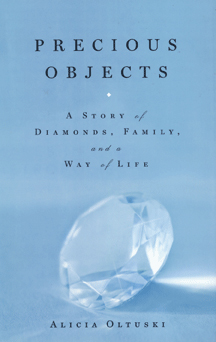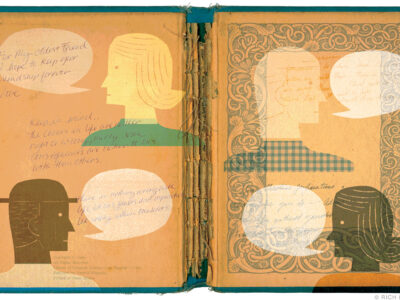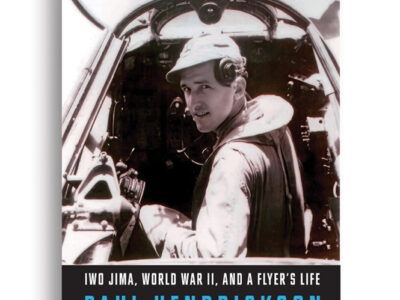Inside the medieval village known as the Diamond District.
By Maureen Corrigan

PRECIOUS OBJECTS: A Story of Diamonds, Family, and a Way of Life
By Alicia Oltuski C’06 G’06
Scribner, 2011. $24.
In 1948 E.B. White momentarily turned his attention away from his day job at The New Yorker, and his life-long fascination with the doings of mice, pigs, and spiders, to write an essay on New York City for Holiday magazine. A year later, that splendid essay was turned into a small book called, with typical simplicity, Here is New York. Among his many pellucid observations is that New York is not, in fact, a single city.
“The city is literally a composite of tens of thousands of tiny neighborhood units,” he wrote. “So complete is each neighborhood, and so strong the sense of neighborhood, that many a New Yorker spends a lifetime within the confines of an area smaller than a country village. Let him walk two blocks from his corner and he is in a strange land and will feel uneasy till he gets back.”
Around the same time White was writing that essay, yet another miniature “city within a city” was materializing right in the heart of Manhattan. The Diamond District is a one-block world-unto-itself on West 47th Street between Fifth and Sixth Avenues. These days, it’s demarcated by two huge, diamond-shaped lights at either end, but back in the late 1930s and early ’40s, the district was just taking shape as Jewish diamond dealers and craftsmen fled Europe. By the end of 1940, Alicia Oltuski says in Precious Objects, 1,500 dealers from Europe had already settled in the city. (That same year, the city’s diamond trade rose to $35 million, an approximate $6 million increase from the previous year.) To accommodate the influx of wartime exiles, the Diamond Dealers Club moved in 1941 from its former headquarters in the “old Diamond District” in Lower Manhattan on Nassau Street to roomier quarters at 36 West 47th St. Dealers and craftsmen—the cleavers, cutters, polishers, and setters who turn rough diamonds into coveted pieces of jewelry—followed. The Diamond District as New Yorkers now know it had fully transplanted itself to its current Midtown location by the 1960s.
Oltuski’s interest in the district and its signature product has come down to her as a family inheritance: her father, who deals in estate jewelry, and her grandfather, a post-World War II Russian Jewish emigrant to New York, both work on 47th Street. Because of that personal connection, Oltuski was given entrée into dingy offices where the floor shines of gold dust from years of jewelry-making, and factories where Hasidic diamond cutters listen to Torah tapes on their headphones. Oltuski also ambitiously aims to go beyond the Diamond District, to give readers a panoramic tour of the diamond industry, past and present: She chronicles the longtime monopoly of the DeBeers Company; the atrocities associated with “blood diamonds”; the annual diamond shows in Miami, Tucson, and Las Vegas; and the emerging weirdo industry of “LifeGem,” which can transform the remains of the dearly departed into diamond jewelry.
Throughout her book, Oltuski meditates on humankind’s long obsession with the meaning of these rocks. (Who knew that Archduke Maximilian of Austria jumpstarted the lucrative equation of diamonds with eternal love when he presented his betrothed with a diamond ring in 1477?) But enlightening as those excursions are, Oltuski’s story dazzles most when she stays close to home. The liveliest chapters in this fascinating book are those that take readers on an insider tour of the highly ritualized world of dealers and craftsmen in the Diamond District.
Oltuski awakens her readers to the incredible fact that, in the very shadow of Radio City, a community exists whose business practices would not have seemed all that foreign to merchants in the Middle Ages. As Oltuski points out: “At any given moment on Forty-seventh Street, a dealer may be in possession of hundreds of thousands of dollars’ worth of another man’s diamonds. Usually, he has not paid the owner any collateral, only his word.”
That word, when given, is invariably between two men—the Diamond District is still very much an old boys’ club—and, frequently, in Yiddish. Oltuski explains:
“Mazal is the word that closes diamond deals all over the world. When two people say Mazal, short for Mazal und brucha—“luck and blessing” in Yiddish—the stone has transferred possession, no matter who is physically holding the gem … I’ve heard Indian dealers say it. Muslim dealers say it. It’s just another way in which the ancient customs of Judaism run deeply through the diamond business.”
What emerges most memorably in Precious Objects is a multifaceted portrait of a New York city-within-a-city, bound by custom and religion and, for some, by obsession with the beauty of diamonds. After reading Oltuski’s book, you won’t be able to look with indifference at diamonds, or the grubby New York street famous for selling them. And, yes, you’ll feel like a dope for ever having paid retail.
Maureen Corrigan Gr’87 is the book critic for NPR’s “Fresh Air,” and teaches a course on the literature of New York City at Georgetown University.




